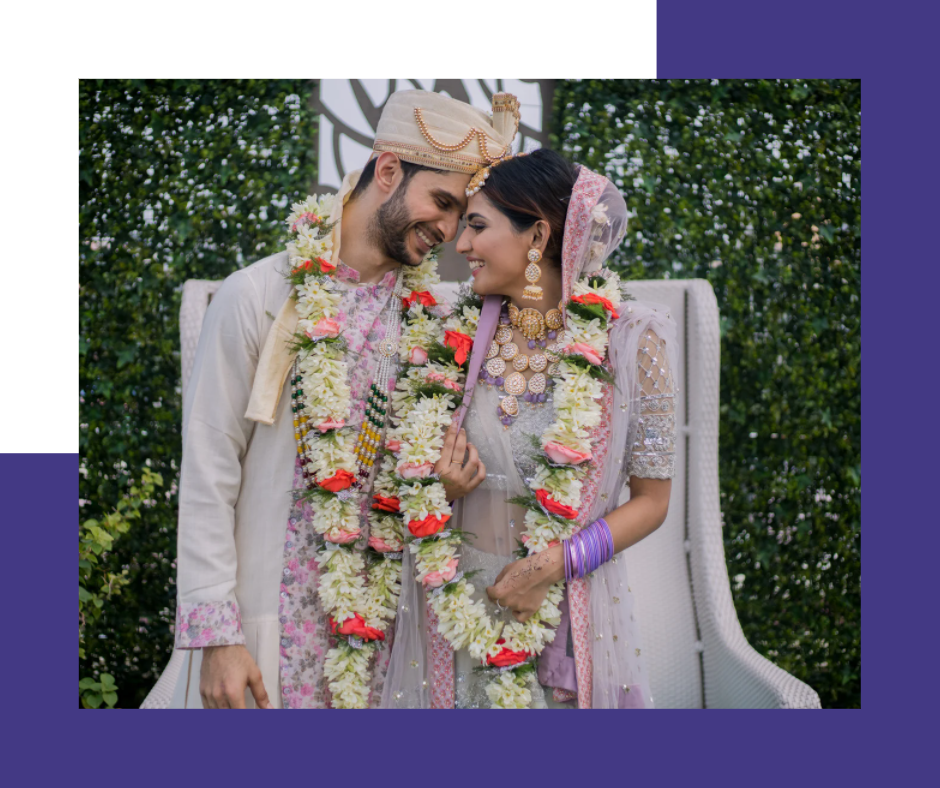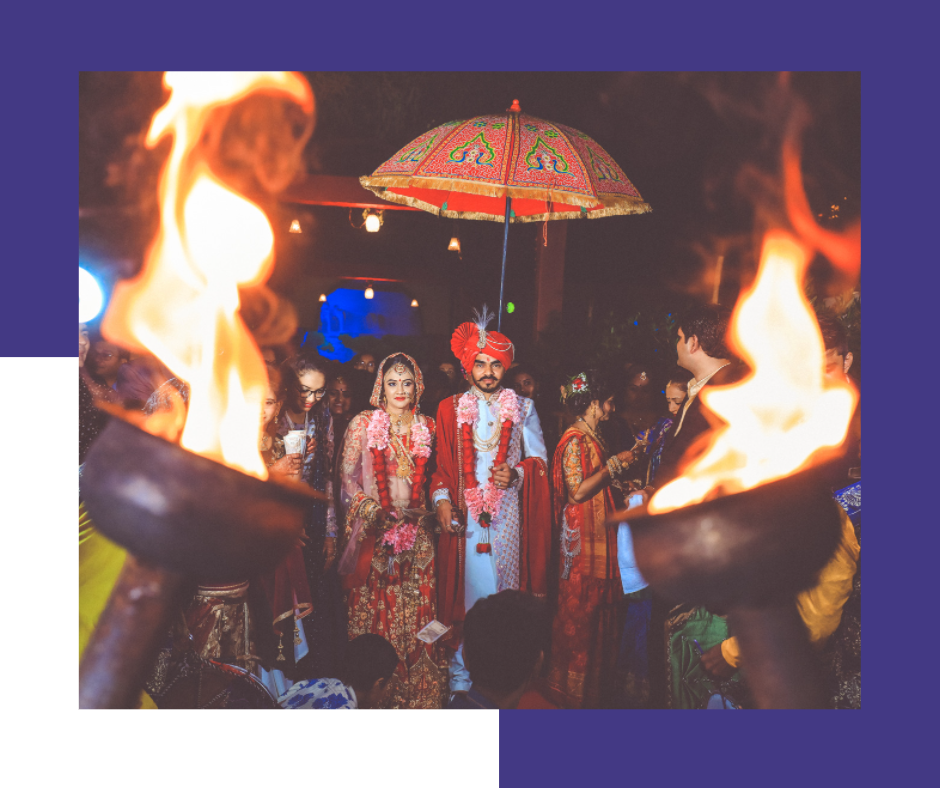
Did you know that Hinduism is the oldest continuing religion in the world? According to historians, it was dated back to 3000 BC. Hinduism is the largest religion behind Christianity and Islam. A Hindu wedding is one of the most sacred rites and incorporates many timeless rituals and customs.
A Hindu wedding ceremony’s essence is two people’s spiritual, mental, and physical union. The ceremony of marriage is conducted according to Vedic traditions its matrimony is sacred, it will be conducted in the ancient Hindu language of Sanskrit, and it will be translated to English by the priest. Hindu weddings must be intricately planned because of the culture-rich festivities that are full of celebration and tradition. This type of wedding is not all about the bride and the groom as it is also about the coming of two families through prayer and traditions.

The Baraat / The Jaan
The wedding day will kick off with the Baraat, It is a celebratory wedding procession for the groom and his family involving live music, singing, and dancing. The Baraat can often do include luxury like cars, horses, yachts, etc. The groom will leave his home with baraat heading to the wedding venue with his family and friends. Once they are in the venue the baraat will commence will dhol players, they will announce the arrival of the groom, his family, and his friends

Pokwanu – The welcoming of the groom
The bride’s family will formally welcome the Groom, his family, and his friends. The mother of the bride will apply tilak on the groom’s forehead and then escorts the groom, his family, and friends to the venue. He is then led inside the priest will perform a brief ceremony. After the ceremony, the mother of the bride will grab the groom’s nose playfully to remind him that it is him who came to their home and ask for the hand of her daughter and he must take care of her from now on. The groom will be then asked to smash a clay pot with his foot breaking it into pieces. This demonstrates that he has the power to overcome all obstacles that the couple may face in their married life. The groom will be then escorted to the Mandap. A Mandap serves as the altar of weddings, specifically for Hindu and Jain ceremonies.
The Ganesh Puja
Ganesh Puja is the celebration of the rebirth of Lord Ganesh as the God of new beginnings and the remover of obstacles as well as the God of wisdom and intelligence. Before the wedding ceremony, the priest will invoke Lord Ganesh, it will be performed by the bride’s parents, the ceremony will begin by offering a prayer to Lord Ganesh requesting peace and harmony to prevail during the ceremony. Traditional Hindu Weddings will be incomplete without Ganesh Puja.
Vaarpooja
Varpooja is translated to “Paying Respect to the Groom”. In the Hindu traditions, the groom is the reincarnation of Lord Vishnu and in that respect, he will be worshiped by the bride’s family. The bride’s parents will perform a ceremony where they will wash the groom’s feet and offer flowers and Mandhuparka. At the end of the ceremony, Antrapat (a veil of cloth) will be held in front of the groom to prevent him and the bride to see each other until specific matters are recited.


Kanya Aagman – The Arrival of the Bride
The bride is escorted to the mandap by her maternal aunt and uncle, Once the bride is inside, verses of Mangalashtak are chanted as the veil is lowered and the couple exchanges flower garlands (Jai-Malas). The bride will be the first one to offer a garland declaring that she has chosen the groom of her own free will. The groom will then return the compliment by offering her a garland welcoming her to a new beginning of their life and promising that he will look after her.

Granthibandan and Varmala
The bride and groom will chant prayers to the Lord Shiva Goddess Parvati, Lord Narayan, and Goddess Laxmi Devi asking for a strong marriage. The groom’s scarf will be tied to the bride’s shawl, the knot symbolizes the union of two souls joined together by holy matrimony

Kanyadaan
Kayadaan means “Giving away the bride”, this ceremony is performed by the bride’s parents. The father of the bride will take his daughter’s right hand and will place it in the groom’s right hand requesting for him to accept his daughter as his equal partner. The parents of the bride will pray that their son-in-law will look after their daughter.

Havan
Is a small sacred ritual that has the list of mandap inviting the Fire God (Agni) as the symbol of light, power, and purity while offering ghee, rice, and flowers to the flame. It is believed that Havan purifies the environment. This ritual is important as Agni dispels darkness and ignorance in life leads us to eternal light and knowledge.

Mangal Fera
Mangal Fera is the couple circle four times in the holy fire to represent the four goals in life and that is righteousness, wealth, desire, and salvation. While they are doing the circle the bride’s brother will bring an offer of rice to the barley.

Saptapadi – The Seven Steps
Saptapadi means “The Seven Steps” and it is the most important rite of a Hindu wedding ceremony, the couple will take seven steps to symbolize the beginning of their journey together for life. The couple will take a vow at the beginning of each step as they receive blessings, after the seventh step, the couple will legally become husband and wife recognized in their faith.



Sindhoor & Mangal Sutra
Now is the exchange of rings, ceremonies will begin wherein their bride and groom are identified as married to each other. The groom will place a sindhoor at the parting of the bride’s hair to symbolize that she is now a married woman. After that he will place a golden necklace with black beads around the bride’s neck, this signifies his love, integrity, and respect for the bride.



Celebration of Marriage
After the marriage ceremony is complete, it’s time for the bride and groom’s family and friends to celebrate.
Akhand Saubhagyavati – Blessings From Married Women
Married women will be invited to greet the couple, they will whisper to the bride’s ear their good wishes for a blissful married life, prosperity, and happiness.
Aashirwad – Blessings
The newly married couple will seek blessings and advice from the priest, relatives, and friends for a happy married life together.

End of the Ceremony
After having lunch, photos will be the final part and after that, the couple will leave the mandap, the bride will be given a handful of rice which she throws over her head behind as she leaves to symbolize a repayment to her parents for all that they have given and sacrifice for her throughout the years. The bride will say a tearful farewell to her maternal family and starts a new life with his husband and his family.
However, this is just the end of the Marriage Ceremony, On the grand reception, there will be a whole glamourous event. It will be less traditional. It will all be about great food and an evening of dancing.

Leave a comment